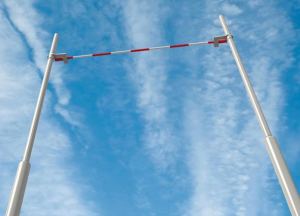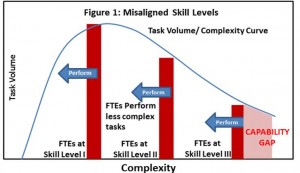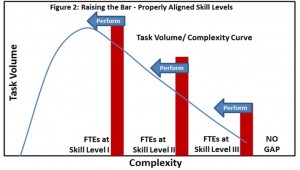 Blogs criticizing the misuse and overuse of Lowest Price Technically Acceptable (LPTA) source selections for services will flood your search engine results in seconds. Because integrity matters, let’s step back and ask the tougher question: How can we effectively apply LPTA source selection to complex services?
Blogs criticizing the misuse and overuse of Lowest Price Technically Acceptable (LPTA) source selections for services will flood your search engine results in seconds. Because integrity matters, let’s step back and ask the tougher question: How can we effectively apply LPTA source selection to complex services?
Can we raise the bar for technical acceptability?
When the requirement is not well defined, development work is required, or performance risk is higher, the more technical and past performance considerations take priority in source selection. However, when the requirement is clearly definable and the risk of unsuccessful contract performance is minimal, cost or price may dominate the other factors. When price dominates, the LPTA source selection process will likely produce the best value (Federal Acquisition Regulation Part 15.101).
LPTA Defined
Before we explore raising the bar, we should take a moment to define what LPTA is and is not.
1. LPTA is a source selection process. It is a method used to select a vendor for a contract with well-defined requirements when there is minimal cost, schedule, or performance risk. It’s best suited for products with clear specifications or simple services. For example, the purchase of a guardforce’s radios, which can be described in terms of quantity, signal strength, range, battery-life, and warranty, is an appropriate LPTA requirement.
2. LPTA is not a price/cost reduction method. Using LPTA to force vendors to sharpen their pencils may produce a lower offered price, but performance may often suffer.
3. LPTA is not a cure for inexperience. We often default to LPTA to avoid the harder road of preparing a detailed source-selection plan, entering into discussions, and conducting the negotiations that could result in a price lower than LPTA with better performance.
Getting LPTA Right
With these clarifications in mind, let’s consider how to get LPTA right for complex services – by raising the bar for technical acceptability. The contracting officer must consider the LPTA source selection process from the perspective of the offerors. Because proposals will be ordered from cheapest to most expensive, and reviewed from the lowest-priced upward until a technically acceptable proposal is found, there is immense pressure to provide the lowest possible price. This sounds like LPTA actually is a price reduction method. Initially offered prices may indeed be lower, but detrimental to the government, as this process forces vendors to find minimally qualified personnel to perform the required services. Because the bar for “minimally qualified” is set by the requirements in the solicitation, it’s critical to set the bar for technical acceptability at the right height to meet the requirement.
 Consider the alignment of the Skill Level bars in Figure 1 against the volume of tasks at varied complexities. In this example, the skill levels and quantities of full time employees (FTEs) have been targeted to address the less complex, higher-volume tasks, leaving a capability gap. This is how we typically set the bar for LPTA skill levels in our requirements. We ask: What’s my greatest need? What skills must a contractor have to fulfill my need? Then we set the bar – the description of our technically acceptable skills in the requirement – to meet that need. This becomes the minimum skill set for the performing contractor.
Consider the alignment of the Skill Level bars in Figure 1 against the volume of tasks at varied complexities. In this example, the skill levels and quantities of full time employees (FTEs) have been targeted to address the less complex, higher-volume tasks, leaving a capability gap. This is how we typically set the bar for LPTA skill levels in our requirements. We ask: What’s my greatest need? What skills must a contractor have to fulfill my need? Then we set the bar – the description of our technically acceptable skills in the requirement – to meet that need. This becomes the minimum skill set for the performing contractor.
Now consider the vendor as it selects personnel to meet those skill requirements. LPTA incents the contractor to find personnel that are minimally qualified to meet each bar. In fact, because higher skilled employees cost more, LPTA punishes vendors for offering higher skilled employees. What is the result? Upon selection of the lowest price – minimally qualified offeror, in execution the focus of each Skill Level is on less complex tasks! The contractors cannot perform the customer’s more complex tasks, because they lack the skills and experience to perform them.
Note the capability gap for the most complex tasks – the contractor’s minimally qualified Skill Level III personnel lack the ability to perform the requirement’s toughest tasks. These tasks, although often fewer, are typically where the most risk, highest cost of failure, and greatest need for contractor expertise lies. The government is dissatisfied with the contractor’s performance, and the contractor is frustrated because it provided what was asked for by the LPTA requirement.
Raising the Bar
 What must be done then is to raise the bar for skills and experience when using LPTA for complex services. Rather than first matching skills with the greatest need when developing the requirement, focus instead on the toughest, high-risk, yet less frequent tasks that demand the contractor’s best efforts (Figure 2).
What must be done then is to raise the bar for skills and experience when using LPTA for complex services. Rather than first matching skills with the greatest need when developing the requirement, focus instead on the toughest, high-risk, yet less frequent tasks that demand the contractor’s best efforts (Figure 2).
Scope that skill level first. Then, review the requirements in decreasing complexity. Ask yourself what skills the contractor will need to address each need without frequently pulling his top performers down to assist with lower-valued tasks. Raise the bar for each skill level to mitigate the need for higher skilled employees to assist them.
Set skill levels and staffing requirements to ensure that you obtain a contracted workforce that has the skills and experience to meet your toughest challenges – at the best possible price. Offered prices may not be as low, but your satisfaction level, performance objectives, and results won’t be sacrificed to a rock bottom price.
For more ideas on how to ensure success with LPTA, plus many other aspects of the acquisition process, be sure to read our free downloadable guide: “Addressing the Complex Challenges Facing Today’s Acquisition Professional,” which we collaborated on with GovLoop. Share it with colleagues and let us know what you think!



